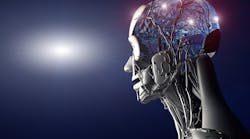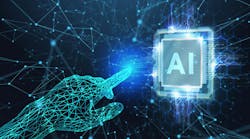Listen to the article on our podcast!
Whether we recognize it or not, dentistry is changing by the minute, and it is important to be aware of advancements that could greatly impact our delivery of care. Artificial intelligence (AI) is technology that allows computers and digital devices to learn, read, write, create, and analyze.1 This type of technology is designed to emulate characteristics associated with intelligence in human behavior, such as language, reasoning, and problem solving.2
If we think about it, AI has been around for years through automated online scheduling, confirming appointments, and calculating office productivity. AI is growing with its implementation in dentistry to assist with accuracy and efficiency of early diagnosis and treatment plans, thus resulting in improved patient outcomes.3 The practice implications and potential limitations of this technology will be explored in this article so that, as clinicians, we can have a foundational understanding of how this could influence the future of dental hygiene practice.
Practice implications
AI is not new in dentistry, as clinicians have been using it for years to ensure quality and precision with treatment.2 However, research is continually evolving to support statistical and clinical significance so that providers can be confident in using this technology. AI in dentistry is intended to serve as an evidence-based decision aid while minimizing error when providing patients with a diagnosis.3 Historically, AI has been incorporated to detect and classify dental restorations, bony lesions, periodontal disease, caries, and has been able to predict possible failures in clinical scenarios.2 When utilizing this technology, there are subtype models to consider. The deep learning-based convolutional neural network (CNN) is a process of data being entered into a system of deep neural networks to analyze an image.2,4 For example, a radiograph is entered into a CNN system and the algorithm detects the structure (e.g., carious lesion), segments it based on the size, and classifies the lesion. The model’s accuracy is constantly being adjusted as radiographs continually get submitted into the system.2 The CNN algorithm has proven effective in identifying caries, detecting apical lesions on panoramic films, and characterizing TMJ health and osteoarthritis.2
In a systematic review looking at AI models for diagnosing gingivitis and periodontitis, two studies developed AI models for detecting plaque resulting in accuracy ranging from 73.6% to 99%; seven studies looked at the ability to diagnose gingivitis from intraoral photos, reporting an accuracy between 74% and 78.2%; and 11 studies looked at the performance of AI models for detecting alveolar bone loss from radiographic images, reporting accuracy between 73.4% and 99%.5 The accuracy of this technology may not quite be at the point where clinicians are confident with using it in their day-to-day practice, but with time and more research, these percentages are expected to increase. AI is intended to refine a clinician’s decision-making process, improve speed of radiographic identification, and assist with early diagnoses; however, there are limitations to this technology.2,3
Limitations
Incorporating AI into dentistry can support the daily practice delivery of experienced clinicians, whereas studies have pointed to increased bias when used by inexperienced clinicians. One study showed that dental students were more likely to over-rely on AI assistance in comparison to students without assistance when diagnosing a challenging furcation involvement.3 Another concern with novice clinicians using AI assistance is if a clinician suspects a diagnosis and the AI technology agrees, the student may not consider alternative diagnoses.3 This same study evaluated efficiency in diagnoses and the use of AI technology did not prove statistically significant in regard to speed in inexperienced clinicians, but there was less variability with diagnoses between clinicians.3 Although AI can certainly present with benefits to support practitioners, it should not be the sole piece of information used when providing treatment or a diagnosis to a patient. When discussing periodontal disease, alveolar bone loss—which is being detected by AI—is not the only clinical marker used. It is also important to consider probe depth, clinical attachment loss, bleeding points, suppuration, and presence of missing teeth.5 This indicates that AI can be widely beneficial in supporting a diagnosis; however, it cannot encompass the entire diagnosis.
Bias is a limitation that many studies look to when evaluating effectiveness of AI. Automation bias may occur if a clinician favors the diagnosis provided by AI and fails to consider alternatives. Anchoring bias is another concern, which would involve a clinician relying too heavily on information provided by AI early in the decision-making process.3 Various study participants claim that AI could be of benefit in supporting clinical decision-making, especially because it can also help the patient definitively understand a diagnosis. However, AI should be just that—a support or enhancement to clinical decision-making, not a replacement or a “crutch.”3
The future of AI in dentistry
It is clear that as research continues to evolve and technology advances, AI could become commonplace in dental practice settings, which is encouraging when considering the volume of oral conditions that could be detected much earlier. There are limited companies with FDA clearance for measuring bone levels and detecting carious lesions.5 AI has the potential to be a strong diagnostic resource that could facilitate improved access to care through telehealth practice models as well. Further studies will contribute to a greater understanding of this technology so that clinicians and patients alike can confidently trust the supplemental information being provided.2,4
Editor's note: This article appeared in the Aug/Sept 2024 print edition of RDH magazine. Dental hygienists in North America are eligible for a complimentary print subscription. Sign up here.
References
- What is artificial intelligence (AI)? IBM. Accessed April 15, 2024. https://www.ibm.com/topics/artificial-intelligence
- Ahmed N, Abbasi MS, Zuberi F, et al. Artificial intelligence techniques: analysis, application, and outcome in dentistry–a systematic review. Biomed Res Int. 2021;2021:9751564. doi:10.1155/2021/9751564
- Glick A, Clayton M, Angelov N, Chang J. Impact of explainable artificial intelligence assistance on clinical decision-making of novice dental clinicians. JAMIA Open. 2022;5(2):ooac031. doi:10.1093/jamiaopen/ooac031
- Tay JRH, Ng E, Chow DY, Sim CPC. The use of artificial intelligence to aid in oral hygiene education: a scoping review. J Dent. 2023;135:104564. doi:10.1016/j.jdent.2023.104564
- Revilla-León M, Gómez-Polo M, Barmak AB, et al. Artificial intelligence models for diagnosing gingivitis and periodontal disease: a systematic review. J Prosthet Dent. 2023;130(6):816-824. doi:10.1016/j.prosdent.2022.01.026









